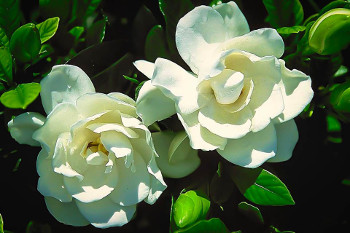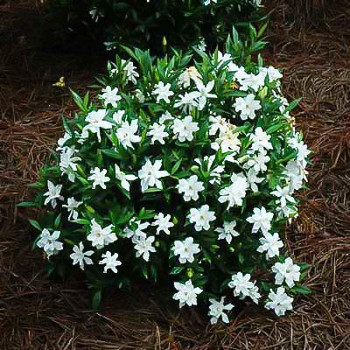The rich, exotic perfume of gardenia blossoms fills the warm air of a southern night. The pure-white flowers glow in the dark, while their heady scent drifts across the garden, enchanting everyone to relax and enjoy life. Nothing says The South like Gardenia blossoms. Like all the best things in life, these beauties need certain conditions to thrive and they need a little care. But when the blossoms begin to open in summer and continue to appear through the year, spreading their rare fragrance, that little trouble will be re-paid a thousand times over.
More practically, Gardenias, which originated in China, are evergreen shrubs that can be grown outdoors in the warmer parts of the country, or indoors in cooler regions. They have a reputation for being difficult to grow, but given the right conditions they will thrive and bring their unique beauty and their spectacular perfume right into your garden or home.
Gardenias are evergreen shrubs that can reach 15 feet in height, but are typically smaller. The leaves are a simple oval shape, around two inches long, of a rich dark-green color and glossy, giving the plant a lovely healthy appearance. The bushes are dense and lush-looking, bringing a lot of beauty to the garden even when not in flower. The stems and trunk are mid-grey in color and the bark is fairly smooth and not flaky.

The flowering season depends on the variety and the growing location and conditions. In Florida, plants bloom from the end of March to mid-June, but many varieties bloom again in late summer and fall. In cooler areas blooming will be later and it is often better to choose a later-blooming variety, such as the August Beauty Gardenia, to have the best results in cooler gardens.
There are numerous varieties of Gardenia, but most are fairly similar. One that does stand out as very different is the Dwarf Radicans Gardenia, which only grows one or two foot tall, with a spread of three to five feet across. The flowers are numerous, just as richly-scented, but smaller, around one inch across.
How you grow your Gardenia will depend on where you live. In warm, humid areas such as Florida and the Gulf, they can be grown as screening plants, hedges, in shrub beds and as specimen plants. The Dwarf Radicans Gardenia makes an excellent ground-cover plant for sunny or partially-shaded areas, because of its low, spreading habit of growth. This variety can also be planted on slopes or at the top of low walls, where it will cascade down in a charming fashion.
In areas where Gardenias are a little more difficult to grow they will probably be placed in a selected site as a specimen plant to be admired. In all cases try to choose a location where the perfume can be carried on the breeze through windows or onto the porch or terrace, so that you can enjoy its beauty to the full.
Gardenias also make excellent potted plants, where they can be moved around to enjoy their fragrance or to give them the best growing conditions. Pots can be placed outdoors when temperatures are over 600F and kept in a sheltered porch, veranda or brought inside when the temperature fall. They can also be successfully grown entirely indoors in a conservatory or a bright window and will scent the whole room when in flower.
Remember when choosing a location for your plants to allow enough room, since plants will become large quite quickly – Gardenias are surprisingly fast-growing trees in good locations. They can easily reach six feet in height and more, and spread six feet across, and you don’t want to have to cut into your beautiful bush because you can’t walk down the path.
The Gardenia, which is also called Cape Jasmine or Cape Jessamine originated in China. There are around 200 species of gardenia throughout Asia, but the usual plant in gardens is Gardenia jasminoides, which is recorded as being grown in China 3,000 years ago during the Song Dynasty. It was first grown in America by Dr. James Gordon, a Scotsman who had moved to Charleston in 1752. He was a botanist as well as a gardener and worked with the famous botanist Linnaeus, who named this plant after him. Dr. Gordon had brought Gardenias to his garden around 1762 and many old plants in the south may be descendants of that original plant, although most Gardenias grown today are more modern varieties.
Due to its beauty and rich perfume the Gardenia became immensely popular in America and Europe, especially during the 1920s and 1930s. The jazz singer Billy Holliday always wore a jasmine corsage in her hair when she performed. Potted shrubs were brought into ballrooms and parties.

The second consideration is location. Gardenias will grow in full sun and also in partial shade. Plants will still grow in deeper shade, but blooming will be reduced. A sheltered location is best, as cold winds can cause leaf-drop, and shelter from drying winds is also helpful, since Gardenias prefer humid conditions. They are not salt-tolerant so do not plant too close to the ocean. Because they love acid soil, keep them away from concrete, such as walls, walkways or driveways, since lime can leach from the concrete and make the soil alkaline, even if it is acid in the rest of the garden.
Temperature is also important and Gardenias will be damaged if the temperatures reach freezing (320F) or lower. Plants growing in the ground will acclimatize to colder conditions above freezing as they grow, but plants in pots that are moved indoors will do best if they are kept above 600F. If you do live in a colder area but lust after Gardenias in your garden, then the Frost-Proof Gardenia is the answer.
This variety is hardy to minus ten degrees, so it will grow all the way up into zone 6. It has good-sized flowers and the same perfume as less-hardy varieties. It is a good choice too if you live at the edge of hardiness for ‘normal’ Gardenias, since it will be insurance against an exceptional frost. This variety will grow to five feet tall and at least four feet across.
Regular watering is also necessary and plants should neither be flooded nor allowed to become completely dry. This is especially important during the flowering season, when water-stress can cause buds to drop. Regular fertilizer is needed for the healthiest plants and for maximum blooming. Feed your plants in early spring and again in early fall.
If growing in good conditions and cared for, Gardenias should remain healthy and pest-free. The can, however, suffer from a few pests – but chemical or organic solutions are available to most problems and if spotted early they can usually be dealt with.
To plant your new Gardenia, dig a hole in prepared ground that is twice the diameter of the pot but only the same depth. Be careful when removing the pot to no disturb the roots. Place your plant in the hole at the same depth or a little less than it was in the pot. Fill the hole half full with soil and water well.
Once the water has drained away replace the rest of the soil, leaving a doughnut-shaped mound around the plant, beyond the root area, to allow for regular deep watering. Mulch your Gardenia with a rich organic layer two or three inches deep. Water your new plant regularly and do not allow it to dry out at all, which can happen quite easily until the roots move out into the surrounding soil.
If you are planting in a container, make sure it has drainage holes. Use a potting soil designed for acid-loving plants and a matching fertilizer. Always let the soil dry a little between watering, but not too much.
Pruning is not necessary unless you want to shape your plant a little, or keep it more compact. The best time to prune or trim is immediately after flowering is over. Over-grown plants can be pruned quite hard if necessary, but flowering may be reduced in the next season as the plant re-builds its structure.
Regular mulching with a layer or rich organic material two or three inches thick in early spring each year will not only conserve moisture and keep the moisture levels more even, it will provide some nutrients as well.
Although some care is needed to grow Gardenias well, the rewards are worth it. Nothing can match the beauty of a bush in bloom and the unique blend of spice and floral in the perfume is your reward for the little effort needed to succeed with these valuable and garden-worthy plants. Now is the time to order your plants and look forward to years of pleasure.





